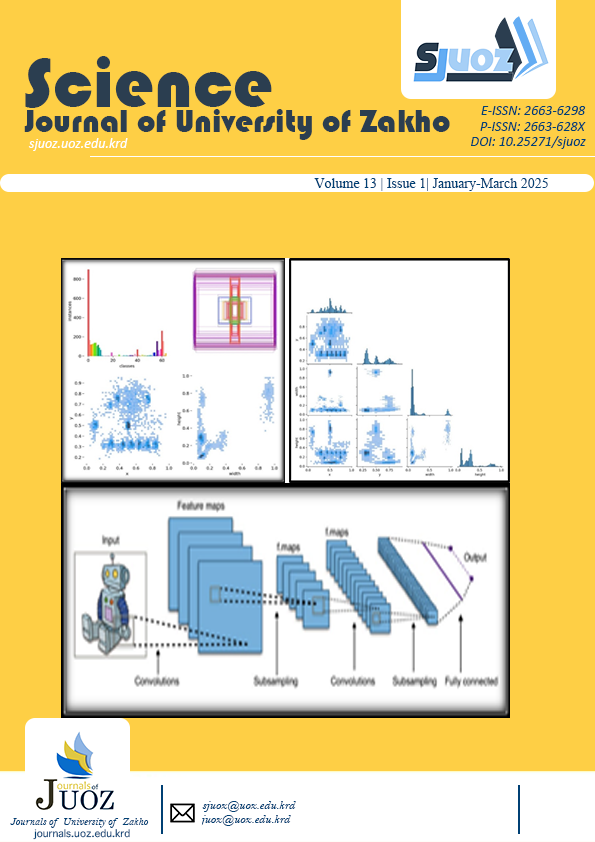A SPECTROSCOPIC IN-VITRO METHOD FOR DETERMINING THE SUN PRODUCTION FACTOR (SPF)AND PHYSICAL PROPERTIES OF MARKETED SUNSCREEN FORMULATIONS
Abstract
Applying sunscreen or lotion protects the skin from harmful ultraviolet rays, reducing the risk of sun exposure-related diseases such as skin cancer. The increasing awareness of these dangers has driven a demand for testing sunscreen formulations. This research utilizes ultraviolet-visible spectroscopy to measure the Sun Protection Factor (SPF) and the UVA/UVB ratio for several different sunscreens from various brands. The SPF values of the tested products range from 15 to 100. The spectroscopy method is simple, fast, and accurate in determining SPF values in a controlled environment. Notably, some sunscreen formulations in the Kurdistan market display SPF values 62.5% below the label amount, indicating that many people in Kurdistan may be using sunscreens with less protection than they believe. Besides evaluating SPF, the research also examines the tested sunscreens' optical band gap and refractive index.
Full text article
References
Andrea, K., Boglárka-Katalin, B., Erzsébet, F., Emese, S., & Ibolya, F. (2022). Determination of the sun protection factor of sunscreens. Bulletin of Medical Sciences, 95(1), 64-77. http://dx.doi.org/10.2478/orvtudert-2022-0004
Behar-Cohen, F., Baillet, G., de Ayguavives, T., Garcia, P. O., Krutmann, J., Peña-García, P., Reme, C., & Wolffsohn, J. S. (2013). Ultraviolet damage to the eye revisited: eye-sun protection factor (E-SPF®), a new ultraviolet protection label for eyewear. Clinical Ophthalmology, 87-104. https://doi.org/10.2147/OPTH.S46189
Bendová, H., Akrman, J., Krejčí, A., Kubáč, L., Jírová, D., Kejlová, K., Kolářová, H., Brabec, M., & Malý, M. (2007). In vitro approaches to evaluation of Sun Protection Factor. Toxicology in vitro, 21(7), 1268-1275. https://doi.org/10.1016/j.tiv.2007.08.022
Cadet, J., & Douki, T. (2018). Formation of UV-induced DNA damage contributing to skin cancer development. Photochemical & Photobiological Sciences, 17(12), 1816-1841. https://doi.org/10.1039/c7pp00395a
Cedrick, A., Devi, S. J., & Joshna, B. Design and Development of 7-Dehydrocholesterol Sunscreen Cream and its Anti-microbial activity. https://DOI.org/10.37896/HTL30.8/11427
Chavda, V. P., Acharya, D., Hala, V., Daware, S., & Vora, L. K. (2023). Sunscreens: A comprehensive review with the application of nanotechnology. Journal of Drug Delivery Science and Technology, 86, 104720. https://doi.org/10.1016/j.jddst.2023.104720
D’Orazio, J., Jarrett, S., Amaro-Ortiz, A., & Scott, T. (2013). UV radiation and the skin. International journal of molecular sciences,14(6),1222212248.https://doi.org/10.3390/ijms140612222
Das, M., Mondal, S., Banerjee, S., & Bandyopadhyay, A. (2017). In vitro sun protection factor determination from dried leaves of Elephantopus scaber L. Using ethanolic extract. Indian Journal of Life Sciences, 6(1), 43. https://www.researchgate.net/publication/313890825
Fonseca, A., & Rafaela, N. (2013). Determination of sun protection factor by UV-vis spectrophotometry. Health Care,1(1),1000108.http://dx.doi.org/10.4172/hccr.1000108
Haryński, Ł., Olejnik, A., Grochowska, K., & Siuzdak, K. (2022). A facile method for Tauc exponent and corresponding electronic transitions determination in semiconductors directly from UV–Vis spectroscopy data.Optical Materials,127,112205. http://dx.doi.org/10.1016/j.optmat.2022.112205
Honari, G., & Maibach, H. (2017). Dermatotoxicology and Sensitive Skin Syndrome. Sensitive Skin Syndrome, 168-195. https://doi.org/10.1201/9781315121048
Kollias, N., Ruvolo Jr, E., & Sayre, R. M. (2011). The value of the ratio of UVA to UVB in sunlight. Photochemistry and photobiology,87(6),14741475.https://doi.org/10.1111/j.1751-1097.2011.00980.x
Majeed, M., Majeed, S., Jain, R., Mundkur, L., Rajalakshmi, H., Lad, P., & Neupane, P. (2020). A randomized study to determine the sun protection factor of natural pterostilbene from Pterocarpus marsupium. Cosmetics, 7(1), 16. https://doi.org/10.3390/cosmetics7010016
Mbanga, L., Mulenga, M., Mpiana, P., Bokolo, K., Mumbwa, M., & Mvingu, K. (2014). Determination of sun protection factor (SPF) of some body creams and lotions marketed in Kinshasa by ultraviolet spectrophotometry. Int. J. Adv. Res. Chem. Sci, 1(8), 7-13.ISSN 2349-039X (Print) & http://www.arcjournals.org/
Mishra, A. K., Mishra, A., & Chattopadhyay, P. (2011). Evaluation of sun protection factor of some marketed formulations of sunscreens by ultraviolet spectroscopic method. J Curr Pharm Res, 5(1), 32-35. https://www.researchgate.net/publication/304345694
Omar, K. A., & Abdulrahman, R. (2015). Determinations of Sun Protection Factor (SPF) of some sunscreens marketed in Kurdistan Region by UV-Visible spectrometry and study their Rheological properties. Int J Pharm Chem, 5, 40-44. http://dx.doi.org/10.7439/ijpc.v5i2.1726
Portilho, L., Aiello, L. M., Vasques, L. I., Bagatin, E., & Leonardi, G. R. (2023). Effectiveness of sunscreens and factors influencing sun protection: a review. Brazilian Journal of Pharmaceutical Sciences, 58, e20693. http://dx.doi.org/10.1590/s2175-97902022e20693
Prakash, P., Lokesh, P., & Manral, K. (2015). A simple and rapid method developed to determine the Sun protection factor (SPF) by using UV-visible spectrophotometer for topical formulations. Journal of Research & Method in Education, 5(1), 1-5. http://www.iosrjournals.org/
Sabzevari, N., Qiblawi, S., Norton, S. A., & Fivenson, D. (2021). Sunscreens: UV filters to protect us: Part 1: Changing regulations and choices for optimal sun protection. International Journal of Women's Dermatology, 7(1), 28-44. https://doi.org/10.1016/j.ijwd.2020.05.017
Sander, M., Sander, M., Burbidge, T., & Beecker, J. (2020). The efficacy and safety of sunscreen use for the prevention of skin cancer.Cmaj,192(50),E1802-E1808. https://doi.org/10.1503/cmaj.201085
Singh, P., & Nanda, A. (2014). Enhanced sun protection of nano‐sized metal oxide particles over conventional metal oxide particles: An in vitro comparative study. International journal of cosmetic science, 36(3), 273-283. http://dx.doi.org/10.1111/ics.12124
Tang, X., Yang, T., Yu, D., Xiong, H., & Zhang, S. (2024). Current insights and future perspectives of ultraviolet radiation (UV) exposure: Friends and foes to the skin and beyond the skin. Environment International, 108535. https://doi.org/10.1016/j.envint.2024.108535
Threes Smijs, P. (2011). Titanium dioxide and Zinc Oxide nanoparticles in sunscreens: focus on their safety and effectiveness. Nanotechnology, Science and Applications, 4, 95. https://doi.org/10.2147/NSA.S19419
Zou, W., Ramanathan, R., Urban, S., Sinclair, C., King, K., Tinker, R., & Bansal, V. (2022). Sunscreen testing: A critical perspective and future roadmap. TrAC Trends in Analytical Chemistry,157,116724. https://doi.org/10.1016/j.trac.2022.116724
Authors
Copyright (c) 2025 Ahmed Hassan kurda

This work is licensed under a Creative Commons Attribution 4.0 International License.
Authors who publish with this journal agree to the following terms:
- Authors retain copyright and grant the journal right of first publication with the work simultaneously licensed under a Creative Commons Attribution License [CC BY-NC-SA 4.0] that allows others to share the work with an acknowledgment of the work's authorship and initial publication in this journal.
- Authors are able to enter into separate, additional contractual arrangements for the non-exclusive distribution of the journal's published version of the work, with an acknowledgment of its initial publication in this journal.
- Authors are permitted and encouraged to post their work online.
